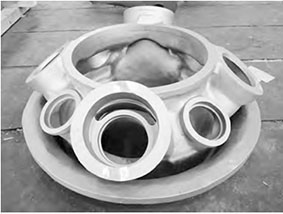Optimization of Differential Pressure Casting for Large Complex Shell Castings
Al-Si alloys exhibit exceptional casting properties, achieving superior mechanical performance, corrosion resistance, and machinability through modification, inoculation, and heat treatment. As the most extensively utilized aluminum casting alloys, they dominate military, aerospace, marine, and transportation applications. Differential pressure casting (DPC), categorized into lower-tank pressurization and upper-tank depressurization methods, employs pressurized chambers to regulate metal flow. Our DPC setup uses upper-tank depressurization: pre-pressurized dry air fills both chambers; upon venting the upper tank, a pressure differential forces molten metal through riser tubes into molds. Solidification under high pressure suppresses hydrogen evolution and enhances feeding capacity, minimizing gas pores, shrinkage cavities, and porosity to yield high-integrity castings. After solidification, residual metal returns to the crucible via gravity.

Technical Requirements for Gearbox Shell Castings
Gearbox shell castings utilize ZL114A alloy, demanding stringent mechanical properties: tensile strength ≥320 MPa, yield strength ≥280 MPa, and elongation ≥6%. Chemical composition and quality must comply with GB/T9438-2013 Class I standards. Critical requirements include:
| Inspection | Standard | Criteria |
|---|---|---|
| X-ray | HB6578 Class I | Zero cracks; porosity control in specified zones |
| Fluorescent Penetrant | Pre-machining | Surface defect screening |
| Kerosene Leak | Post-machining | Zero leakage in internal cavities |
| Hydraulic Test | 0.35 MPa, 15 min | Sealed with aviation oil (4450#) |
This shell casting features a truncated cone structure (Ø600/Ø1200 × 1300 mm) with uneven wall thicknesses: main body (14 mm), partitions (20 mm), ribs (18 mm), and annular sections (40–90 mm). Complex geometries like internal partitions, oil channels, and thick annular hubs create thermal hotspots prone to shrinkage defects.
Initial DPC Process and Defect Analysis
ZL114A’s high Mg content (0.4–0.75%) enhances strength via Mg2Si precipitation but increases oxidation sensitivity. DPC parameters were optimized to control filling velocity and pressure gradients:
| Parameter | Value | Phase |
|---|---|---|
| Synchronized Pressure | 600 kPa | Pre-filling |
| Lifting Speed | 45 mm/s | Riser filling |
| Filling Pressure | 75 kPa | Mold filling |
| Solidification Pressure | 15 kPa | Crystallization |
Despite DPC’s advantages over gravity/low-pressure casting, X-ray inspection revealed shrinkage porosity in partitions and annular hubs. Sectioning identified thermal segregation as the root cause. The annular hub’s geometry (thick center, thin ends) exceeded riser feeding distance, while partition complexity prevented effective chilling. The feeding distance limitation follows:
$$
L_f = k \sqrt{V}
$$
where \(L_f\) = effective feeding distance, \(V\) = casting volume, and \(k\) = material constant. For ZL114A, \(k\) ≈ 4.5, but geometric constraints reduced \(L_f\) by 30%.
Optimized Process: Chill Sands and Feed Aids
To resolve shrinkage, we integrated chromite sand chill cores and feed aids:
- Chromite sand cores replaced silica sand in partition regions. Its high thermal conductivity (\( \kappa_{chromite} = 4.5 \text{W/m·K} \) vs. \( \kappa_{silica} = 1.5 \text{W/m·K} \)) accelerated cooling, enabling simultaneous solidification. Cooling rate enhancement is quantified as:
- Feed Aids in Annular Hub: Wedge-shaped feed aids and tapered chills created artificial temperature gradients, extending riser effectiveness by 40%. The modified feeding distance became:
$$
\frac{dT}{dt} = \frac{\kappa \cdot A \cdot \Delta T}{m \cdot C_p}
$$
where \(A\) = surface area, \(m\) = mass, \(C_p\) = specific heat, and \(\Delta T\) = temperature gradient.
$$
L_{f-modified} = L_f + \alpha \cdot h_{subsidy}
$$
where \(h_{subsidy}\) = subsidy height, \(\alpha\) = geometric factor (0.8 for wedge design).
Validation and Industrial Impact
Post-optimization, X-ray confirmed defect-free shell castings meeting all mechanical and leak-test standards. Key outcomes:
- Chromite sand reduced partition solidification time by 35%, eliminating microporosity.
- Feed aids increased \(L_{f-modified}\) to 120 mm, enabling full hub feeding.
- DPC parameter stability ensured repeatability across production batches.
This methodology demonstrates that strategic chill sand placement and feed aid design can overcome inherent limitations in large shell casting production, particularly for aerospace and marine components where integrity is non-negotiable.
